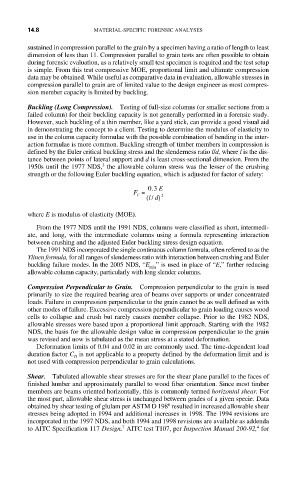Page 517 - Forensic Structural Engineering Handbook
P. 517
14.8 MATERIAL-SPECIFIC FORENSIC ANALYSES
sustained in compression parallel to the grain by a specimen having a ratio of length to least
dimension of less than 11. Compression parallel to grain tests are often possible to obtain
during forensic evaluation, as a relatively small test specimen is required and the test setup
is simple. From this test compressive MOE, proportional limit and ultimate compression
data may be obtained. While useful as comparative data in evaluation, allowable stresses in
compression parallel to grain are of limited value to the design engineer as most compres-
sion member capacity is limited by buckling.
Buckling (Long Compression). Testing of full-size columns (or smaller sections from a
failed column) for their buckling capacity is not generally performed in a forensic study.
However, such buckling of a thin member, like a yard stick, can provide a good visual aid
in demonstrating the concept to a client. Testing to determine the modulus of elasticity to
use in the column capacity formulae with the possible combination of bending in the inter-
action formulae is more common. Buckling strength of timber members in compression is
defined by the Euler critical buckling stress and the slenderness ratio l/d, where l is the dis-
tance between points of lateral support and d is least cross-sectional dimension. From the
3
1950s until the 1977 NDS, the allowable column stress was the lesser of the crushing
strength or the following Euler buckling equation, which is adjusted for factor of safety:
.
03 E
F =
C 2
ld)
( /
where E is modulus of elasticity (MOE).
From the 1977 NDS until the 1991 NDS, columns were classified as short, intermedi-
ate, and long, with the intermediate columns using a formula representing interaction
between crushing and the adjusted Euler buckling stress design equation.
The 1991 NDS incorporated the single continuous column formula, often referred to as the
Ylinen formula, for all ranges of slenderness ratio with interaction between crushing and Euler
buckling failure modes. In the 2005 NDS, “E ” is used in place of “E,” further reducing
min
allowable column capacity, particularly with long slender columns.
Compression Perpendicular to Grain. Compression perpendicular to the grain is used
primarily to size the required bearing area of beams over supports or under concentrated
loads. Failure in compression perpendicular to the grain cannot be as well defined as with
other modes of failure. Excessive compression perpendicular to grain loading causes wood
cells to collapse and crush but rarely causes member collapse. Prior to the 1982 NDS,
allowable stresses were based upon a proportional limit approach. Starting with the 1982
NDS, the basis for the allowable design value in compression perpendicular to the grain
was revised and now is tabulated as the mean stress at a stated deformation.
Deformation limits of 0.04 and 0.02 in are commonly used. The time-dependent load
duration factor C is not applicable to a property defined by the deformation limit and is
D
not used with compression perpendicular to grain calculations.
Shear. Tabulated allowable shear stresses are for the shear plane parallel to the faces of
finished lumber and approximately parallel to wood fiber orientation. Since most timber
members are beams oriented horizontally, this is commonly termed horizontal shear. For
the most part, allowable shear stress is unchanged between grades of a given specie. Data
6
obtained by shear testing of glulam per ASTM D 198 resulted in increased allowable shear
stresses being adopted in 1994 and additional increases in 1998. The 1994 revisions are
incorporated in the 1997 NDS, and both 1994 and 1998 revisions are available as addenda
4
7
to AITC Specification 117 Design. AITC test T107, per Inspection Manual 200-92, for

